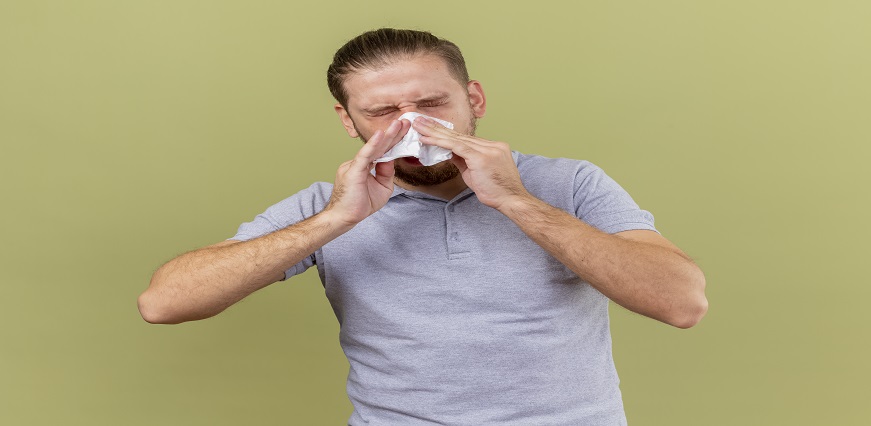


Nosebleeds occur when one of the blood vessels in your nose ruptures. They can be caused by an infection, injury, allergic reaction, picking your nose or another object being wedged into your nose. Nosebleeds are quite common in children and are usually not serious; however, you should seek medical attention if they're frequent or prolonged.
Nosebleeds happen all the time. Sometimes they're scary, but they don't usually indicate anything severe. The nose has lots of blood vessels, close to the surface at the front and back of the nose. They’re as fragile as polka dots and are easily traumatized by things like blowing your nose too hard, sneezing and picking your nose. Nosebleeds are common in adults and children 3-10 years old.
A nosebleed (sanguinolent epistaxis) can happen in two spots.
Nosebleeds can be caused by a number of things, including but not limited to: allergies, picking at or blowing your nose too hard, high blood pressure, hereditary hemorrhagic telangiectasia (a condition that causes enlarged blood vessels), and trauma to the face or head.
There are four types of nosebleeds: anterior, posterior, epistaxis, and caudal. Anterior nosebleeds make up 90% of all nosebleeds and occur when blood vessels in the front of the nose break. Posterior nosebleeds are much less common and occur when blood vessels in the back of the nose break. Epistaxis is a medical term for bleeding from the nostrils and can be caused by both anterior and posterior nosebleeds. Caudal nosebleeds are very rare and occur when blood vessels in the base of the skull rupture.
There are a few different things that can cause nosebleeds, which is why it’s important to see your doctor if you experience them frequently. Here are some of the most common causes:
Most nosebleeds are not serious and can be treated at home. However, if you have a nosebleed that lasts longer than 20 minutes or soaks through more than one gauze pad, you should seek medical attention.
Symptoms of a nosebleed may include:
There are a few things you can do to prevent nosebleeds:
If you have allergies, take steps to control them. Allergies can dry out the inside of your nose and make it more susceptible to bleeding.
There are many potential causes of nosebleeds, but the most common is simply drying out of the nasal passages. This can be caused by everything from cold weather to allergies to medications. If you experience frequent nosebleeds, it's important to see a doctor to rule out any underlying medical conditions. In most cases, though, nosebleeds are nothing to worry about and can be treated at home with simple self-care measures.
Nose Bleeding, also known as epistaxis, is a common condition that usually occurs when the blood vessels in your nose break.
It is not uncommon for people to experience nosebleeds when they are under a great deal of stress. Stress is often a trigger.
There are many possible causes of nosebleeds, but the most common cause is dryness. The lining of the nose dries out and cracks, allowing blood to seep through.
Nosebleeds can occasionally be a symptom of allergies, Infections, Nasal Trauma, and cancer of the nose or sinuses.
Foods that can cause nosebleeds are spicy foods, acidic fruits, and hot beverages like coffee and Tea.
To avoid nose bleeding you have to keep your nostrils clean by gently blowing your nose and using a humidifier. Apply a thin layer of petroleum jelly or other moisture barriers to the inside of your nostrils.
Nosebleeds are not usually signs of high blood pressure, but they can be a symptom of an underlying condition that may cause high blood pressure.
Most nosebleeds can be treated at home by pinching the nostrils shut for 10 minutes or longer while leaning forward. This puts pressure on the bleeding vessel and allows it to clot.
 Allergy Test
Allergy Test
 Anemia Test
Anemia Test
 Auto immune
Auto immune
 Blood disorder
Blood disorder
 Bone and Joint
Bone and Joint
 Cancer Test
Cancer Test
 Cardiology Test
Cardiology Test
 Covid Recovery
Covid Recovery
 Dengue Test
Dengue Test
 Depression
Depression
 Diabetes Test
Diabetes Test
 Fatigue
Fatigue
 Fever Test
Fever Test
 Full body
Full body
 Gastro Test
Gastro Test
 Gastrointestinal
Gastrointestinal
 Gynaecology Test
Gynaecology Test
 Heart Test
Heart Test
 HIV Test
HIV Test
 Hormone Test
Hormone Test
 Hypertension
Hypertension
 Immunity Test
Immunity Test
 Infectious Disease
Infectious Disease
 Infertility Test
Infertility Test
 Influenza Test
Influenza Test
 Iron Test
Iron Test
 Kidney Test
Kidney Test
 Liver Test
Liver Test
 Lung Test
Lung Test
 Nephrology
Nephrology
 Obesity
Obesity
 Orthopedics Test
Orthopedics Test
 Physician
Physician
 Pollution Health Checkup
Pollution Health Checkup
 Pregnancy Test
Pregnancy Test
 Prostate Test
Prostate Test
 Senior Citizen Test
Senior Citizen Test
 STD Test
STD Test
 Thyroid Test
Thyroid Test
 Tuberculosis Test
Tuberculosis Test
 Vitamin Test
Vitamin Test
 Women Health Test
Women Health Test